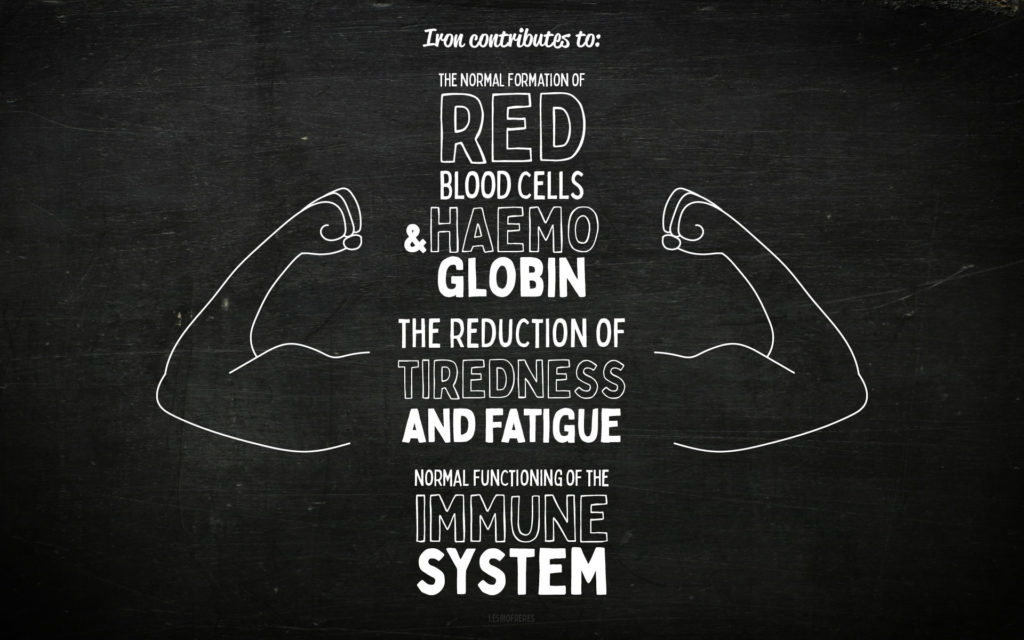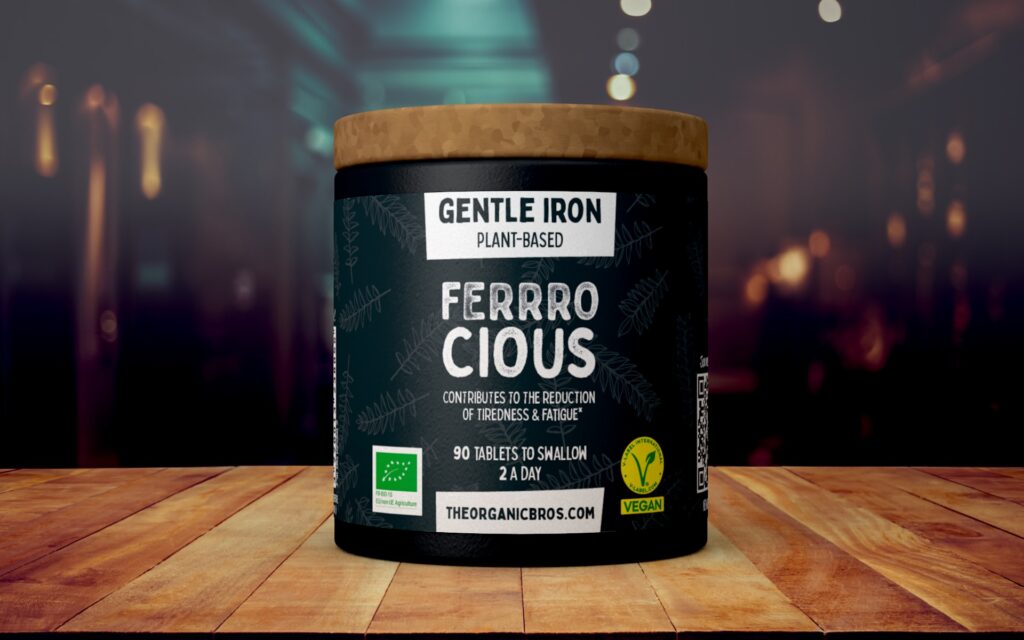Iron: definition, sources and deficiencies in 5 min
Reading time: 5 minutes | Written with love by: Alexis
Iron is very important! If you want to know why read this article by Alexis which tells you everything about what science says about it, the sources, the deficiencies...

Iron, a short definition
Iron is the most common metal in everyday life. It is the most abundant mineral in meteorites and the core of planets. Iron spontaneously reacts in the presence of water and oxygen to form iron oxide: rust.
Oops, sorry, wrong subject, let’s go back to dietary iron instead…
What is the purpose of dietary iron?
Iron is involved in various biological functions, one of the most important of which is the transport of oxygen from the lungs to all the cells of the body.
This transport is possible via haemoglobin, of which iron is one of the main components. Haemoglobin is therefore a protein containing iron (metalloprotein), present in the blood of vertebrates within the red blood cells. It transports oxygen from the respiratory system to the rest of the body. It releases oxygen into the tissues allowing cellular respiration which provides the energy of living systems (ATP; find more information on this subject in our article on vitamin B12.

What are the signs of iron deficiency?
Iron deficiency affects the body as iron contributes to:
- the reduction of tiredness and fatigue
- normal formation of red blood cells and haemoglobin
- normal functioning of the immune system
An iron deficiency is defined as a decrease in blood ferritin.
Distribution of iron in the body
| Male of 70kg | Female of 60kg | |
| Active iron : – haemoglobin (70% of iron) – myoglobin* (6% or iron) – enzymes and cytochromes** | 3g 0,3g 0,3g | 2,5g 0,2g 0,3g |
| Plasma transport: transferrin*** | 4mg | 4mg |
| Storage: ferritin**** | 0,8 – 1g | 0,4 – 0,5g |
| Total iron | 50-60mg/Kg | 40-50mg/Kg |
* Myoglobin : Myoglobin: an iron-containing metalloprotein found in the muscles of vertebrates. It is structurally similar to haemoglobin (it is part of the same family, the haemoproteins), but its function is to store oxygen rather than to transport it.
** Enzymes and cytochromes : are part of the mitochondrial respiratory chain that allows the production of ATP, but also of the biological systems that allow DNA synthesis.
*** Transferrin : is a serum protein (found in plasma). Its function is to transport iron from the intestine to stores in the liver.
**** Ferritin : is a protein that stores iron . It therefore plays a key role in the metabolism of iron, allowing its intestinal absorption to be regulated according to the body’s needs. Measuring ferritin enables iron reserves to be checked and thus detect an iron deficiency early or, on the contrary, detect a rise in iron reserves during treatment with iron supplements.
Iron sources and absorption
Food is the only source of iron for the human body, and its distribution is in haem (from blood) and non-haem (from plants) forms.
Vegan and vegetarian diets don’t contain haem iron.
Non-haem iron from plants is mainly found in its oxidised form ( Fe3+ ), which is not directly bioavailable and so needs to be reduced to the Fe2+ form to be transported across the intestinal epithelium (1) .
Studies have shown that the amount of iron absorbed from a mixed diet (containing meat) varies from 14% to 17%.
However, the amount of non-haem iron absorbed by a vegetarian diet is between 5% and 12% (2).
Another study found similar results with 18% of iron coming from a mixed diet and 10% coming from a plant-based diet (3).
The amount of non-haem iron absorbed is twice as high on a mixed diet than on a vegetarian diet, so we can see from this that taking supplements is necessary for vegetarians.
What foods are rich in iron ?
| Iron content in mg per 100g of food item | |||
| kombu seaweed | 45,6 | 20 | |
| dried brewer’s yeast | 18 | roasted coffee | 17 |
| black tea | 17 | 15 | |
| cocoa powder | 13 | sesame | 10 |
| poppy seed | 9,5 | broad bean | 9 |
| wheat germ | 8,6 | flax seeds | 8,2 |
| lentils | 8,0 | quinoa | 8,0 |
| chick peas | 7,5 | pistachios | 7,3 |
| soya | 6,6 | white bean | 6,5 |
| sunflower seed | 6,3 | chick peas | 6,1 |
| brown sugar | 6,0 | oats | 5,8 |
| algue nori | 5,2 | dried apricot | 4,4 |
| spelt | 4,4 | nettle | 4,1 |
| almond | 4,1 | algue wakame | 3,9 |
| hazel nuts | 3,8 | buckwheat | 3,8 |
| Jerusalem artichoke | 3,7 | parsley | 3,6 |
| truffle | 3,5 | Brasil nut | 3,4 |
| spinach | 3,4 | onion | 3,3 |
| dried fig | 3,3 | black salsify | 3,3 |
| wheat | 3,2 | brown rice | 3,2 |
| barley | 2,8 | rye | 2,8 |
| cashew nut | 2,8 | fennel | 2,7 |
| walnut | 2,5 | coconut | 2,3 |
| raisins | 2,3 | prunes | 2,3 |
| lamb’s lettuce | 2,0 | wild salsify | 2,0 |
| date | 1,9 | green cabbage | 1,9 |
| green olive | 1,8 | peanut | 1,8 |
The high iron content of black pudding (blood sausage) and liver is explained by its high blood content.
The bioavailability of non-haem iron is influenced by various components of food that enhance or inhibit its absorption.
The main inhibitor of non-haem iron absorption is phytic acid (also known as phytate), which can be found in pulses (legumes), nuts and whole grains.
Soaking and sprouting the pulses, grains and seeds will reduce phytic acid levels BUT will remove beneficial nutrients such as zinc. Phytic acid, is also a powerful antioxidant that reduces the risk of many chronic diseases including cancer (4-6). So it’s maybe best to keep it.
Other inhibitors of non-haem iron absorption are polyphenols ie. coffee, cocoa, red wine….(7,8).
In short……we may be in a spot of trouble.
The most important enhancer of iron absorption is vitamin C, which can improve absorption up to six fold in deficient individuals and even in the presence of phytic acid or polyphenols (9-10). Vitamin C facilitates the conversion of ferric iron (Fe3+) to ferrous iron (Fe2+) (the absorbable version, remember).
We advise you to take your iron with a glass of freshly squeezed oranges or, for those who don’t have the time to squeeze their own, with a quality fruit juice bought in your favourite shop
If you look below, you will see that the curry leaves, where the iron in our food supplement comes from, also contain vitamin C, which will naturally boost iron absorption!
1. https://www.vegetarisme.fr/comment-devenir-vegetarien/alimentation-equilibree/fer/
2. Hallberg L, Rossander-Hulthén L. Iron requirements in menstruating women. Am J Clin Nutr. 1991;54(6):1047–1058.
3. Food and Nutrition Board and Institute of Medicine. Dietary Reference Intakes for Vitamin A, Vitamin K, Arsenic, Boron, Chromium, Copper, Iodine, Iron, Manganese, Molybdenum, Nickel, Silicon, Vanadium, and Zinc. Washington, DC: National Academy Press; 2001.
4. Harland BF, Morris ER. Phytate: a good or bad food component? Nutr Res 1995; 15: 733-754. doi: 10.1016/0271-5317(95)00040-P.
5. Slavin JL. Mechanisms for the impact of whole grain foods on cancer risk. J Am Coll Nutr 2000; 19 (3 Suppl): 300S-307S.
6. Fox CH, Eberl M. Phytic acid (IP6), novel broad spectrum anti-neoplastic agent: a systematic review. Complement Ther Med 2002; 10: 229-234.
7. Hurrell RF, Reddy M, Cook JD. Inhibition of non-haem iron absorption in man by polyphenolic-containing beverages. Br J Nutr 1999; 81: 289-295.
8. Lim KH, Riddell LJ, Nowson CA, Booth AO, Szymlek-Gay EA. Iron and zinc nutrition in the economically-developed world: A review. Nutrients. 2013;5(8):3184–3211.
9. Hallberg L. Bioavailability of dietary iron in man. Annu Rev Nutr 1981; 1: 123-147.
10. Hallberg L, Hulthén L. Prediction of dietary iron absorption: an algorithm for calculating absorption and bioavailability of dietary iron. Am J Clin Nutr 2000; 71: 1147-1160.
11. Davidsson L. Approaches to improve iron bioavailability from complementary foods. J Nutr 2003; 133 (5 Suppl 1): 1560S-1562S
Iron in Ferrrocious from the Bio Frères

Murraya Koenigii (curry leaf) is a medicinal plant, native to India, which is used in the composition of our Organic Ferrrocious.
The leaves are naturally rich in many phytonutrients: magnesium, selenium, calcium and especially iron. In addition, they also contain a source of vitamin C, which helps iron absorption.
In short, curry leaves contain a non-haem and bioavailable iron that can be easily absorbed thanks to enhancers like vitamin C naturally present in the extract !
See also
https://www.vegetarisme.fr/comment-devenir-vegetarien/alimentation-equilibree/fer/

Written with love by: Alexis
Alexis is a researcher. True guardian of the temple, he ensures the effectiveness of formulas, compliance and product certifications. He also manages our scientific monitoring and the in-depth articles on our blog.